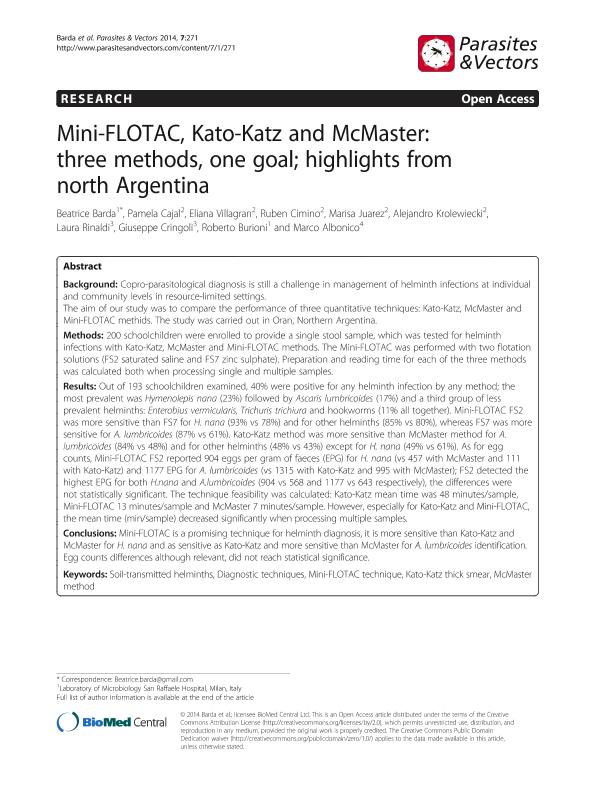Mostrar el registro sencillo del ítem
dc.contributor.author
Barda, Beatrice
dc.contributor.author
Cajal, Pamela
dc.contributor.author
Villagran, Eliana
dc.contributor.author
Cimino, Ruben
dc.contributor.author
Juarez, Marisa
dc.contributor.author
Krolewiecki, Alejandro Javier

dc.contributor.author
Rinaldi, Laura
dc.contributor.author
Cringoli, Giuseppe
dc.contributor.author
Burioni, Roberto
dc.contributor.author
Albonico, Marco
dc.date.available
2016-08-18T14:30:08Z
dc.date.issued
2014-06
dc.identifier.citation
Barda, Beatrice; Cajal, Pamela; Villagran, Eliana; Cimino, Ruben; Juarez, Marisa; et al.; Mini-FLOTAC, Kato-Katz and McMaster: three methods, one goal; highlights from north Argentina; Biomed Central; Parasites And Vectors; 7; 271; 6-2014; 1-7
dc.identifier.issn
1756-3305
dc.identifier.uri
http://hdl.handle.net/11336/7234
dc.description.abstract
Background: Copro-parasitological diagnosis is still a challenge in management of helminth infections at individualand community levels in resource-limited settings.The aim of our study was to compare the performance of three quantitative techniques: Kato-Katz, McMaster andMini-FLOTAC methids. The study was carried out in Oran, Northern Argentina.Methods: 200 schoolchildren were enrolled to provide a single stool sample, which was tested for helminthinfections with Kato-Katz, McMaster and Mini-FLOTAC methods. The Mini-FLOTAC was performed with two flotationsolutions (FS2 saturated saline and FS7 zinc sulphate). Preparation and reading time for each of the three methodswas calculated both when processing single and multiple samples.Results: Out of 193 schoolchildren examined, 40% were positive for any helminth infection by any method; themost prevalent was Hymenolepis nana (23%) followed by Ascaris lumbricoides (17%) and a third group of lessprevalent helminths: Enterobius vermicularis, Trichuris trichiura and hookworms (11% all together). Mini-FLOTAC FS2was more sensitive than FS7 for H. nana (93% vs 78%) and for other helminths (85% vs 80%), whereas FS7 was moresensitive for A. lumbricoides (87% vs 61%). Kato-Katz method was more sensitive than McMaster method for A.lumbricoides (84% vs 48%) and for other helminths (48% vs 43%) except for H. nana (49% vs 61%). As for eggcounts, Mini-FLOTAC FS2 reported 904 eggs per gram of faeces (EPG) for H. nana (vs 457 with McMaster and 111with Kato-Katz) and 1177 EPG for A. lumbricoides (vs 1315 with Kato-Katz and 995 with McMaster); FS2 detected thehighest EPG for both H.nana and A.lumbricoides (904 vs 568 and 1177 vs 643 respectively), the differences werenot statistically significant. The technique feasibility was calculated: Kato-Katz mean time was 48 minutes/sample,Mini-FLOTAC 13 minutes/sample and McMaster 7 minutes/sample. However, especially for Kato-Katz and Mini-FLOTAC,the mean time (min/sample) decreased significantly when processing multiple samples.Conclusions: Mini-FLOTAC is a promising technique for helminth diagnosis, it is more sensitive than Kato-Katz andMcMaster for H. nana and as sensitive as Kato-Katz and more sensitive than McMaster for A. lumbricoides identification.Egg counts differences although relevant, did not reach statistical significance.
dc.format
application/pdf
dc.language.iso
eng
dc.publisher
Biomed Central

dc.rights
info:eu-repo/semantics/openAccess
dc.rights.uri
https://creativecommons.org/licenses/by-nc-sa/2.5/ar/
dc.subject
Mini Flotac
dc.subject
Geohelmintos
dc.subject
Ascaris
dc.subject
Diagnosticos
dc.subject.classification
Parasitología

dc.subject.classification
Ciencias de la Salud

dc.subject.classification
CIENCIAS MÉDICAS Y DE LA SALUD

dc.title
Mini-FLOTAC, Kato-Katz and McMaster: three methods, one goal; highlights from north Argentina
dc.type
info:eu-repo/semantics/article
dc.type
info:ar-repo/semantics/artículo
dc.type
info:eu-repo/semantics/publishedVersion
dc.date.updated
2016-08-04T17:24:15Z
dc.journal.volume
7
dc.journal.number
271
dc.journal.pagination
1-7
dc.journal.pais
Reino Unido

dc.journal.ciudad
Londres
dc.description.fil
Fil: Barda, Beatrice. San Raffaele Hospital; Italia
dc.description.fil
Fil: Cajal, Pamela. Universidad Nacional de Salta. Sede Regional Oran. Instituto de Investigación de Enfermedades Tropicales; Argentina
dc.description.fil
Fil: Villagran, Eliana. Universidad Nacional de Salta. Sede Regional Oran. Instituto de Investigación de Enfermedades Tropicales; Argentina
dc.description.fil
Fil: Cimino, Ruben. Universidad Nacional de Salta. Sede Regional Oran. Instituto de Investigación de Enfermedades Tropicales; Argentina
dc.description.fil
Fil: Juarez, Marisa. Universidad Nacional de Salta. Sede Regional Oran. Instituto de Investigación de Enfermedades Tropicales; Argentina
dc.description.fil
Fil: Krolewiecki, Alejandro Javier. Universidad Nacional de Salta. Sede Regional Oran. Instituto de Investigación de Enfermedades Tropicales; Argentina. Consejo Nacional de Investigaciones Científicas y Técnicas. Centro Científico Tecnológico Salta. Instituto de Patología Experimental; Argentina
dc.description.fil
Fil: Rinaldi, Laura. Universidad de Napoles Federico III; Italia
dc.description.fil
Fil: Cringoli, Giuseppe. Universidad de Napoles Federico III; Italia
dc.description.fil
Fil: Burioni, Roberto. San Raffaele Hospital; Italia
dc.description.fil
Fil: Albonico, Marco. Ivo de Carneri Foundation; Italia
dc.journal.title
Parasites And Vectors

dc.relation.alternativeid
info:eu-repo/semantics/altIdentifier/doi/10.1186/1756-3305-7-271
dc.relation.alternativeid
info:eu-repo/semantics/altIdentifier/doi/http://dx.doi.org/10.1186/1756-3305-7-271
dc.relation.alternativeid
info:eu-repo/semantics/altIdentifier/url/http://www.ncbi.nlm.nih.gov/pmc/articles/pmid/24929554/
dc.relation.alternativeid
info:eu-repo/semantics/altIdentifier/pmid/24929554
dc.relation.alternativeid
info:eu-repo/semantics/altIdentifier/url/https://parasitesandvectors.biomedcentral.com/articles/10.1186/1756-3305-7-271
Archivos asociados
